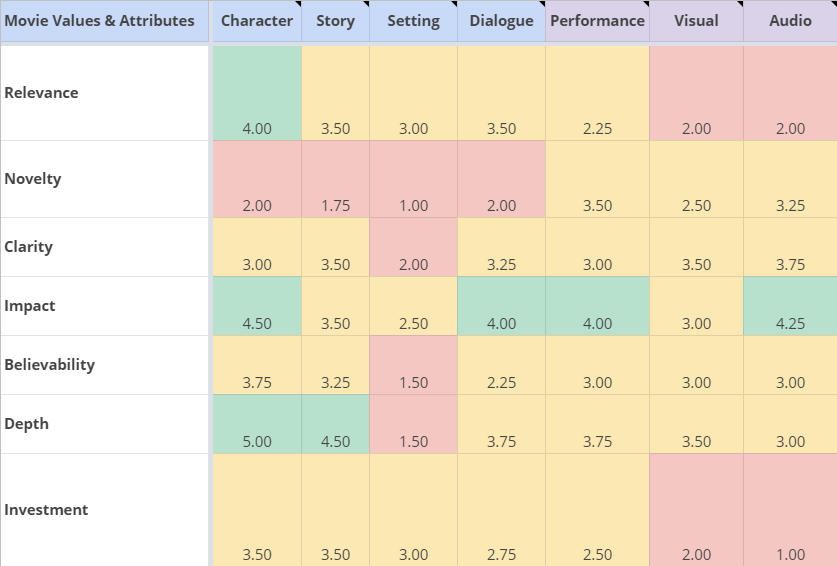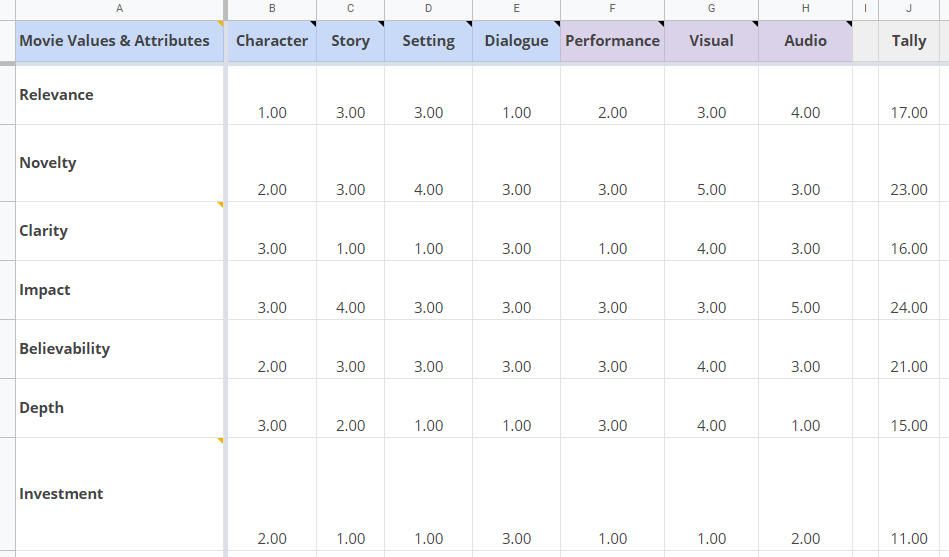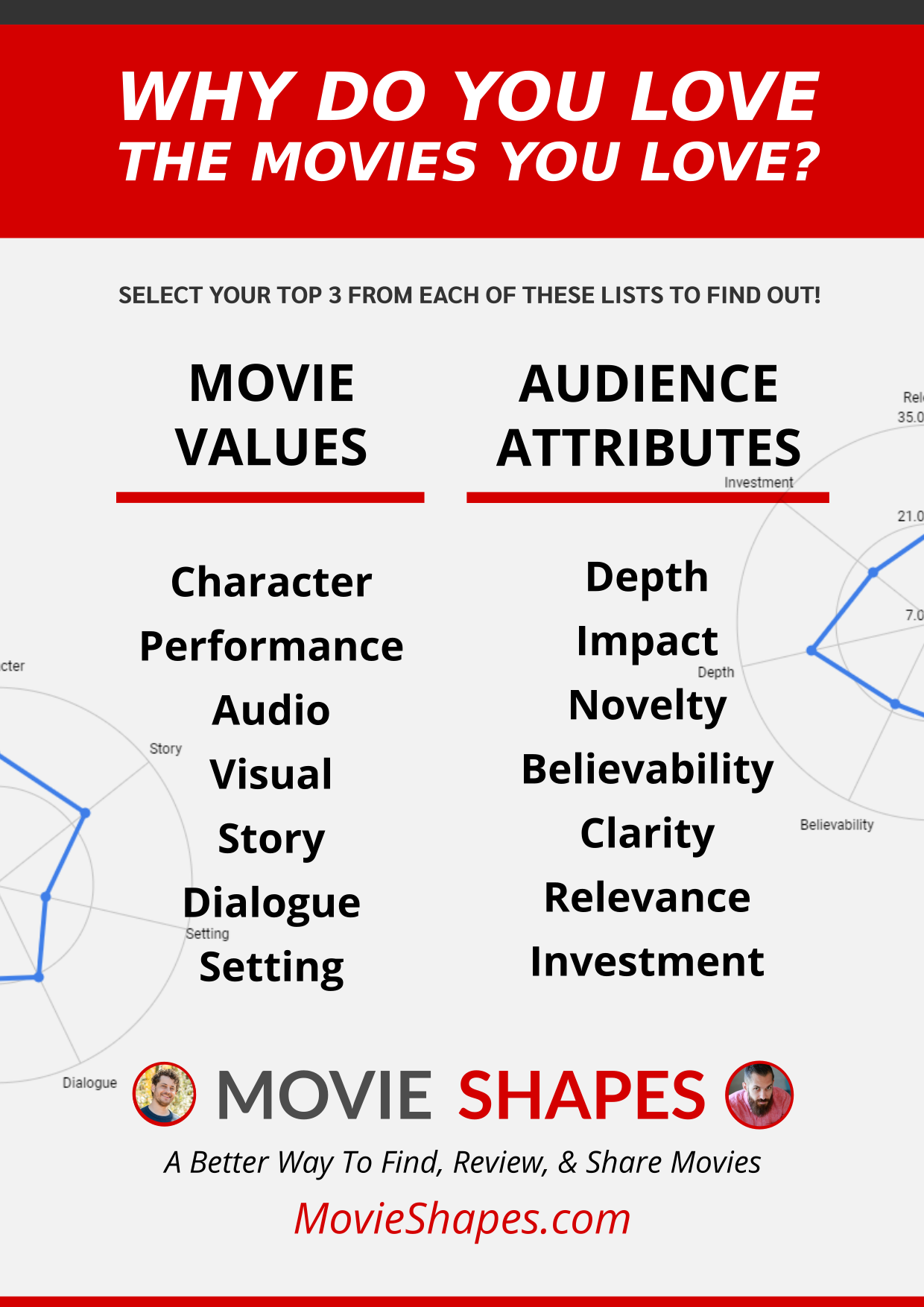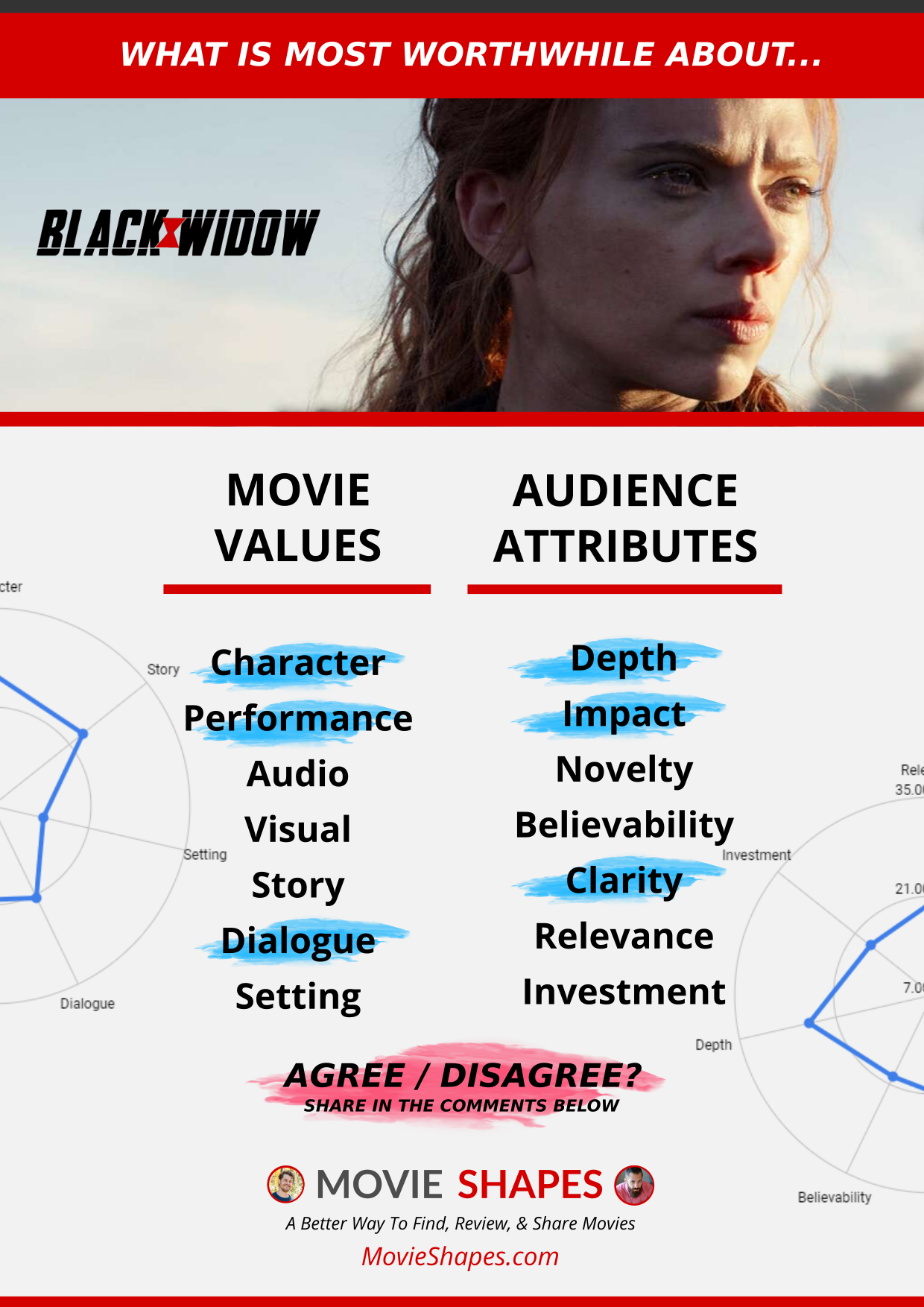Movie Shapes — A Better Way To Find, Review & Share Movies You Love (or Don’t)
The
Problem
How frustrated were you the last time you read a film critic’s positive review only to be disappointed when the movie ended?
Do you remember that time you watched a movie recommended by a friend and you suspiciously wondered after watching it why they thought you would like it?
Do you remember the last time you saw a movie with a high Rotten Tomatoes score and you came out disappointed, questioning that score? Or you finished a movie you loved with a low score?
How often do you endlessly scroll Netflix or Hulu movie recommendations looking for one to watch only to be disappointed by the suggestions?
Very? Yes? Yes? Yes? Often?
We fellow cinephiles share your pain and we’ve got a solution for us all.
We call it Movie Shapes.
Movie Shapes is not an outright replacement for movie labeling and review systems that already exist. Rotten Tomatoes and other system movie labels can be shorthand ways to evaluate a movie. What we want to understand is, what’s informing why people like a movie or don’t. Why do certain groups gravitate towards certain films while others are repulsed? Why do some people who generally like entirely different movies sometimes find a common ground film? Why do some people like and call a film “bold”?
For example, two people may like a particular suspenseful movie, but why they each like it is for entirely different reasons — one person might like the clarity the story provides and another might like the tension (impact) it builds. Most rating systems fail to distinguish why, hence the many frustrations.
Aside from genre, content, and structure, Movie Shapes simply breaks down the fundamentals of a story and the key aspects that are used when transferring a story into the film medium (or television).
The goal of Movie Shapes is to overcome the problems of unhelpful reviewer ratings, confusing audience feedback, bad streaming algorithm matches, and arguments between friends on whether a movie is good (or not).
Everyone’s shape for themselves should be pretty different (like fingerprints). Everyone should be able to assess a movie’s shape with loose agreement. But, based on their own shape, they may differ to the degree of the values and how much those values dictate the film’s level of excellence (of failure).
The similarity or difference between your shape and a movie’s shape should help decide whether you’ll like it before watching and your similarity to someone else’s shape will tell you how much you can rely on their ratings of a film. If someone shares your Movie Shape, they’re more likely to recommend movies you would enjoy in the same ways.
How It Works
Avoid The Following Awkard Situation, Choose Movie Shapes
Movie Shape Samples
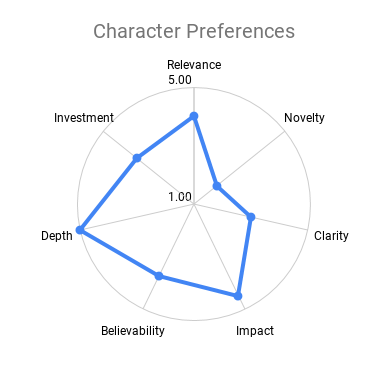
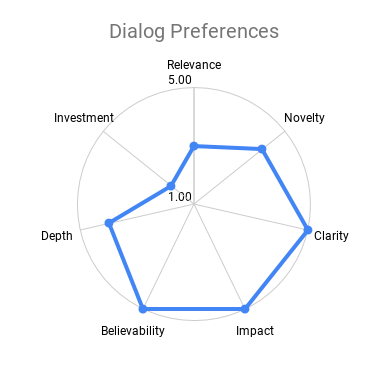
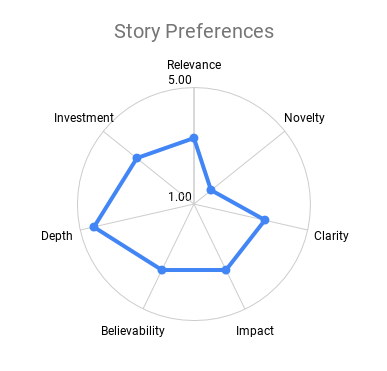
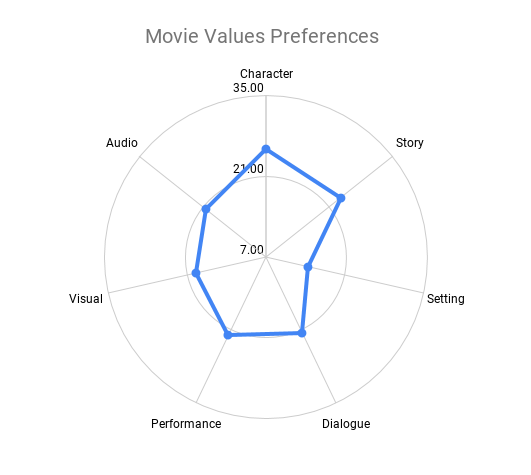
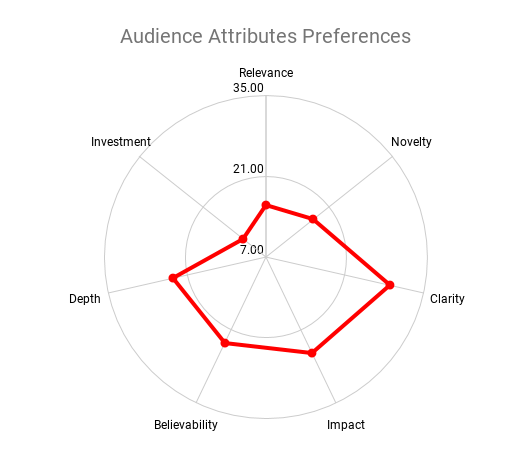
The Movie Shapes Structure
The Movie Shapes rating system is a matrix of attributes applied to a viewer and the movies they watch. Think of it in the likes of a personality assessment but this is more of a values test for which aspects of a movie matter most. When the scoring matrix is completed and mapped into a radar chart, we get a Movie Shape.
Explore the values matrix elements below.
Movie Shapes Dimension 1 — The Story & Movie Elements
Story Elements
Character
Story
Setting
Dialogue
Movie Elements
These elements are those that are unique to movies (or TV shows).
Performance
Visual
Audio
Movie Shapes Dimension 2 — The Preferred Audience Elements
Across the left side of the prototpye spreadsheet are the audience elements. These are where and how the viewer intersects with the movie.
Relevance
Novelty
Clarity
Impact
Believability
Depth
Investment
Investment: The degree of importance to which you get a return on your investment (while watching or rewatching it). By paying attention to details, is there a reward? By rewatching, do these elements enrich the experience? Is there ambiguity for me to own the interpretation (as opposed to being explicitly told)?
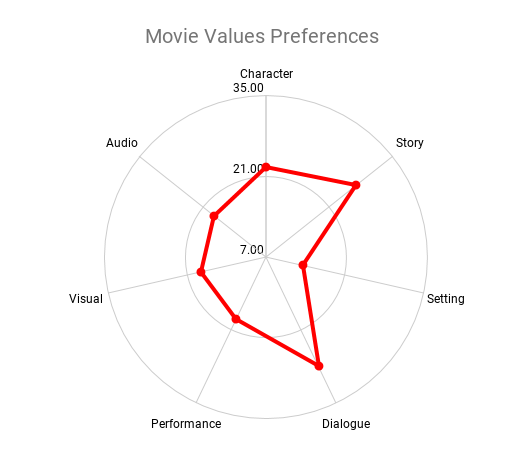
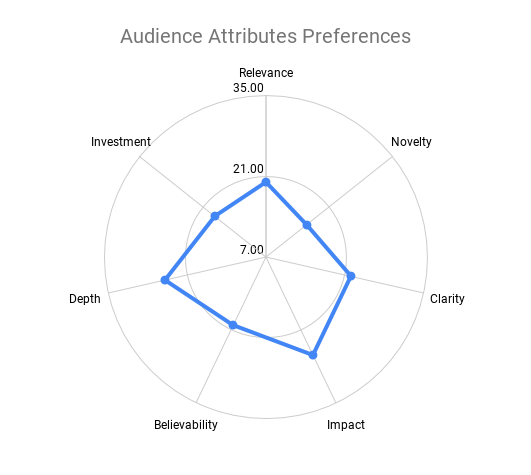
Your Movie Shapes Profile
Think of your movie shapes as fingerprints. They are not worse or better because of their shape. They are unique to you and not intended to create a hierarchy of what’s better or worse among movie watchers.
Explore Profile Creation Instructions Below
Option 1 — Quickly List Your Profile Hierarchy
To start using Movie Shapes without building your full profile, create a simple priority hierarchy.
In a notepad simply rank from 1-7 the movie values and attributes. Using the Movie Shapes Assessment spreadsheet update the "Quick Profile Hierarchy" row and column with your priority ranking.
Movie
Values
-
Character
-
Performance
-
Audio
-
Visual
-
Story
-
Dialogue
-
Setting
Audience
Attributes
-
Depth
-
Impact
-
Novelty
-
Believability
-
Clarity
-
Relevance
-
Investment
Option 2 — Construct Your SIMPLE Movie Shapes Profile
To create your Movie Shape you'll need to either construct a simple or complete profile using our prototype tool. The simple profile is much easier and quicker to score although it is is less accurate and precise.
To get started with Movie Shapes, we recommend going with this option.
Scoring each category between 1 and 5, use a higher number to indicate the importance and a lower to diminish its importance. No individual number can be scored above 5 and the total tally must remain under 21.
Examples
-
Relevance = 3.50
-
Character = 4.25
-
Setting = 2.00
-
Depth = 3.75
-
Etc...
Option 3 — Construct Your COMPLETE Movie Shapes Profile
To get the full range of Movie Shapes benefits, we recommend completing the full profile using the prototype assessment spreadsheet we've built.
When the 7 movie and audience elements from above are cross-matched, we’re left with 49 attributes for scoring.
Examples
-
Character Clarity
-
Story Novelty
-
Performance Depth
-
Visual Relevance
-
Etc...
Scoring Limitations
The template spreadsheet has all fields defaulted to a score of 3. To make it easier, we recommend picking five cross-sections that you would give a 5 and five cross-sections you would give a 1. Those become your poles to which you can compare as you score the remaining fields. Start moving your cross attribute scores up and down by 1, 0.5, or 0.25 until you have it where you want it and your score is 147 points in total.
When creating your profile, you will use the following scale.
-
Least Important
-
-
-
-
-
-
-
Most Important
Tips For Scoring Paralysis & Fine Tuning
One At A Time
Look at one column (character, for example) and the scores you have for each cell. Adjust your scores based on what feels right or wrong. Once done, go to the next column. Once you’ve finished all the columns, do the same thing but look at the scores by row (Clarity, for example).
Favorite Movies
Think about your favorite movies. What attribute and cross attribute are the contributing reason as to why you like it?
Adding Up?
Look at the column or row tally scores to see if the attributes are scoring the way you expect and want at a higher level. Adjust your individual attributes accordingly.
Shaping Up?
Look at the shapes radar charts in the different focus points to see if things are “shaping up” the way you expect and want.
Attribute Comparison
Compare two individual attributes with the same score. Increase the score on the one that is more important by 0.25 and decrease the other by 0.25.
Revisit
After you score yourself initially, revisit it a week later and adjust it. Come back again a month later and adjust again. If your adjustments are getting smaller, you’re moving in the right direction.
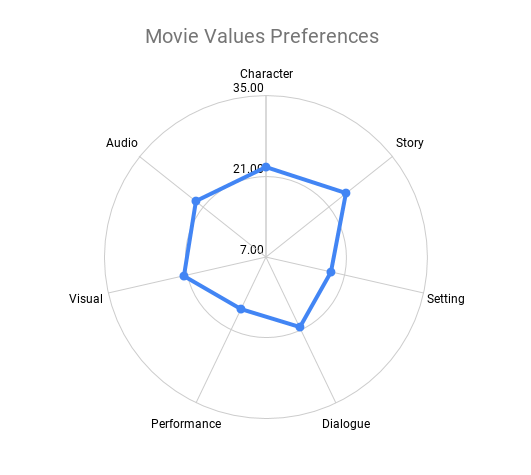
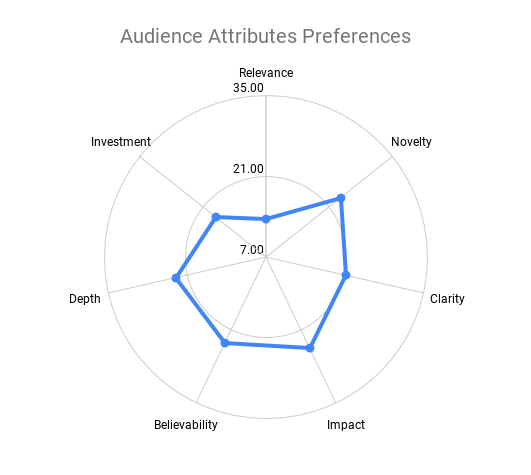
Evaluating & Sharing Movies
With a Movie Shapes profile complete, you can now begin the process of rating movies, sharing with others what you love most, and making relevant recommendations to your friends with profiles.
Explore Movie Evaluation Instructions Below
Option 1 — Quick Movie Rating Hierarchy
If you don’t want to take the time to rate a movie across all 49 attributes, here is a fast process to do a quick movie shape rating and to understand why you like or don’t like it (or why you should or shouldn’t consider someone’s recommendation).
1. Select, in order of priority, the top 3 of 7 movie/story attributes based on the prominence each in the film you just watched.
2. Do the same for the preferred movie audience values and select the top 3 of 7.
3. Compare the selected top 6 values of the movie with the top 6 in your movie shape profile to determine if the factors that you care most about are found in the film you watched (or were recommended).
Quick Movie Rating Example
For example, Jason Montoya rated the top 6 attributes for the movie Bushwick (2017).
Top 3 Movie Values
-
Visual
-
Setting
-
Performance / Matched Profile Value
Top 3 Audience Attributes
-
Impact / Matched Profile Value
-
Novelty
-
Clarity / Matched Profile Value
Three of the movie’s top six values matched Jason’s top six which is why, despite its 5.2 score on IMDB, it was a film he enjoyed.
Option 2 — Fully Rating A Film With Movie Shapes
When rating a movie with the full scoring sheet, there are a few differences to consider compared to scoring your personal preferences.
The movie scoring scale measures how prominent the element is, relative to other elements, within the movie. Ideally, we evaluate a movie’s attribute prominence detached from our own personal profile.
-
Least Prominent
-
-
-
-
-
-
-
Most Prominent
The scoring perspective is also slightly different for the audience attributes. See descriptions below.
Relevance
The amount of relevance this film's attribute is to me, my interests, my context, my journey, and my future aspirations.
Novelty
Compared to other films you've seen, how unique is this film in this particular attribute? How different is it from what you've come to expect?
Clarity
How strong is this film's clarity (uniformity, self-contained, unambiguous) in this attribute?
Impact
How strong is the movie's intelectual, emotional, and physiological effect on me in this attribute?
Believability
How believable is this film in this attribute, and where it's not, how much does it effectively suspend my disbelief.
Depth
How strong is this attribute's depth, interconnectedness, and sophistication?
Investment
The degree of importance to which my investment pays off. The continued value of rewatches. The strength in the attribute's prevalence for allowing my own interpretation versus dictating one on me.

Backstory, Creators, Links, & Your Feedback
Frustrated by the limitations of traditional movie reviews and recommendation systems and inspired at the onset of the pandemic, Addison Williams and Jason Scott Montoya explored several ideas on how to address this problem.
Addison translated their related email thread into a spreadsheet scoring system. Jason reviewed and made an upgraded version. Together they continued to workshop it into Movie Shapes.
Meet the creators, explore their Movie Shapes profile, and visit their recommended links.
Addison
Blu
Williams
Addison Blu Williams is a comedy screenwriter, Special Operations combat veteran, former professional gamer, musician, member of Mensa, and an entrepreneur.


Jason
Scott
Montoya
Jason Scott Montoya is a digital marketing specialist and author of two books, one for aspiring freelancers — Path of the Freelancer — and another for striving small business owners — The Jump.
On his blog, He shares stories and systems to live better and work smarter. Jason lives with his wonderful wife and five cherished children in the Atlanta, Georgia area.
Addison's Movie Shapes


Comparison Overlay
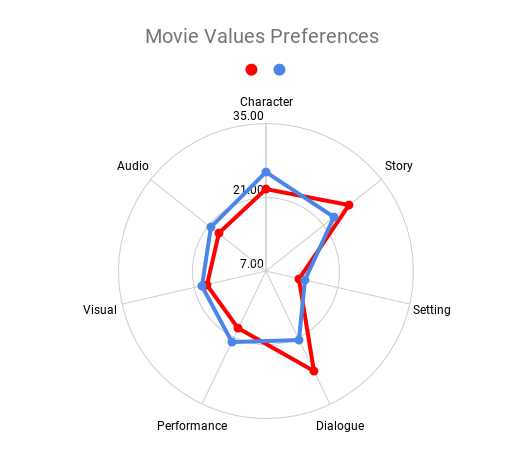
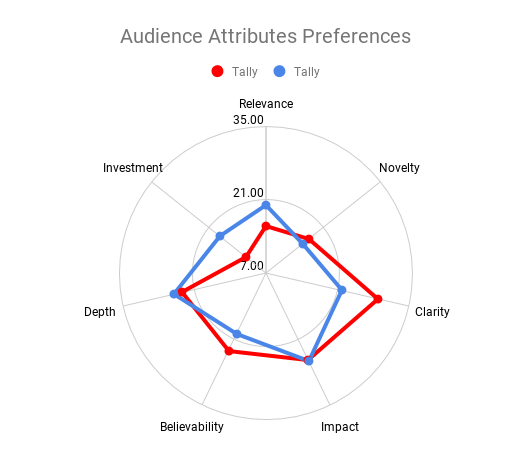
Jason's Movie Shapes


Addison's Top 7 Cross-Attributes
-
Dialogue Clarity
-
Dialogue Impact
-
Dialogue Believability
-
Story Impact
-
Story Clarity
-
Story Depth
-
Audio Impact
Jason's Top 7 Cross-Attributes
-
Character Depth
-
Character Impact
-
Story Depth
-
Audio Impact
-
Dialogue Impact
-
Performance Impact
-
Character Relevance
Quick Profiler Card Sorter
Movie Values
Character
This includes the characters, their development, and their being.Story
This includes the conflict, experiences, and story resolution.Setting
This includes the context of the story and characters, genre of film, and other related elements.Dialogue
The written lines of dialogue actually spoken, not how they are performed.Performance
This includes the acting and interactions unique to the performance.Visual
This attribute includes how the story, characters, and setting are visually presented on the screen.Audio
This includes how the sound (music, effects) dance between each other and interface with the visuals.
Audience Attributes
-
Relevance
The degree to which the attribute is relevant to me, my interests, my current context, my past journey, and my future aspirations. Novelty
The degree of importance that the attribute is novel or uniquely presented in the particular attribute. It's different from what I've come to expect.-
Clarity
The degree of importance the element's themes are uniform, self-contained, and unambiguous. -
Impact
Preference on the degree to which the movie has an intellectual, emotional, and physiological effect on me. Believability
The degree of importance that the movie's attribute is believable, and where it's not, it effectively suspends my disbelief.Depth
The degree of importance of this attribute is deep, interconnected, and not easily labeled or simply explained (complex).-
Investment
The degree of importance to which you get a return on your investment (while watching or rewatching it). By paying attention to details, is there a reward? By rewatching, do these elements enrich the experience? Is there ambiguity for me to own the interpretation (as opposed to being explicitly told)?
Links & Resources
-
Letterboxd is a global social network for grass-roots film discussion and discovery. Use it as a diary to record and share your opinion about films as you watch them, or just to keep track of films you’ve seen in the past.
-
Scener is a wonderful website to facilitate move watch parties online and is compatible with all the major streaming platforms. Don't watch movies at home alone, instead, watch with friends you love!
-
ReelGood is an easy-to-use platform and app for tracking TV shows based on what episodes you've already watched and what's available on your streaming subscriptions. Like Letterboxd, it also allows you to track and rate movies.
-
/Film is a wide-ranging movie news website featuring commentary, industry updates, creator interviews, and much more regarding the world of stories told through film.
Relevant Movie News
Help Spread The Word
Discover Your Friend's Movie Shapes
Share the following with your friends. Ask them what is their top 3 from each list.
Develop Shapes For Movies You Love
Share your Movie Shapes review and foster a discussion. Easily Editable Graphic coming soon.

